ALGAE – DEFINITION, CHARACTERISTICS, CLASSIFICATION, EXAMPLES
Algae and Fungi were first included in the group cryptogamia, established by Linnaeus. Later, this group was divided into Thallophyta, Bryophyta and Pteridophyta. Of these, Thallophyta included Algae and Fungi.
The group Thallophyta shows following characteristics.
- Absence of differentiation into stem, root and leaves.
- Sex organs generally unicellular, if multicellular, sterile envelope or jacket is absent.
- Zygote does not develop into multicellular embryo while inside the female sex organ.
Thallophyta is one of the largest group of Plant Kingdom. The members of this group are found in almost all the types of habitats. Though algae and fungi are customarily placed under Thallophyta, they are very different from one another, in their morphological features, metabolism, reproduction and life histories.
Algae and fungi differ from one another mainly due to presence of chlorophyll in the former and its absence in the latter. This makes algae autotrophic and fungi remains heterotrophic. Reserve food in Algae is the form of starch while fungi store glycogen. Algal cell walls are made of cellulose and those of fungi are composed of chitin.
The present day delimitation of algae is due to A.L. de lussieu (1789). Algae is mostly found in water though some are terrestrial and some are even parasitic (Cephaleuros virescence, a green alga causes Red Rust of Tea). They are as small as bacteria and as large as Macrocystis (a brown alga, 196 feet long). Algae show a great range of thallus structure-as simple as a single cell of Chlamydomonas and as complicated as an internally differentiated kelp (brown algae).
The algal cells are similar to those of higher plants. The characteristic colour of algae is due to specific pigments present in plastids.
Algae reproduce by vegetative, asexual and sexual methods. Sexual reproduction varies from simple isogamy to advanced oogamy. Few groups of algae also exhibit a distinct and well-defined isomorphic and heteromorphic alternation of generations.
Algae have been variously classified by numerous phycologists, their views always differing. The most simple and practical classification was proposed by British phycologist F.E. Fritsch in 1935.
CLASSIFICATION OF ALGAE
DISTINGUISHING CHARACTERS OF ALGAE TAXA
SUB-DIVISION :- ALGAE
- Thallus simple
- Chlorophyll present
- Cell wall of cellulose
CLASS I. CHLOROPHYCEAE
- Grass green plastids
- Starch is reserve food
- Flagella of reproductive structures equal in length
Order 1. VolvocaIes
- Thallus with motile flagellated cells.
Family 1. Chlamydomonadaceae
- Thallus unicellular
- Contractile vacuoles present
Example. Chlamydomonas
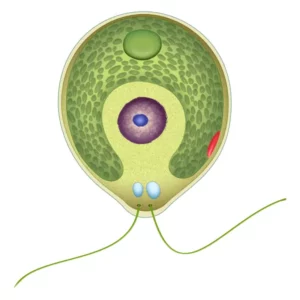
Family 2. Volvocaceae
- Thallus colonial
- Cells in a colony forming a flat plate
Examples :-Pandorina, Eudorina, Pleodorina, Volvox
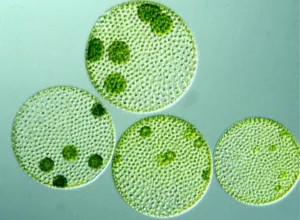
Order 2. Chlorococcales
- Cells single and non-motile
- Cells uninucleate
- Reproduction by zoospores or autospores
Family 1. Chlorellaceae
- Cells single, if united do not form a definite colony
- Reproduction by autospores
Example :-Chlorella
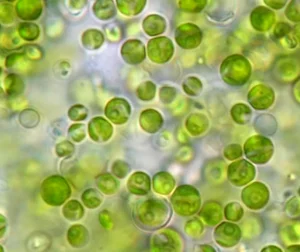
Family 2. Hydrodictyaceae
- Cells united to form coenobe
- Reproduction by zoospores and biflagellate gametes
Examples :-Pediastrum, Hydrodictyon
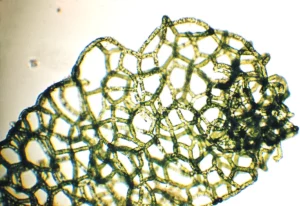
Family 3. Coelastraceae
- Reproduction by autospores
- Autospores apposed to one another at the time of liberation
Example :- Scenedesmus
Order 3. Ulotrichales
- Thallus simple or a branched filament
- Cells uni-or multinucleate
- Single chloroplast with 1 or more pyrenoids
Family 1. Ulotrichaceae
- Unbranched filaments
- Cell walls not articulated
- Cells uninucleate
- Example :- Ulothrix
Family 2. Ulvaceae
- Thallus expanded, 1 or 2 cells thick
- Cells uninucleate with laminate cup-shaped chloroplast
Examples :- Ulva, Enteromorpha
Order 4. Cladophorales
- Branched or unbranched filaments
- Cells cylindrical and multinucleat
Family 1. Cladophoraceae
- Cells more than eight times longer than broad
- Chloroplasts do not form distinct transverse bands
Example :- Cladophora
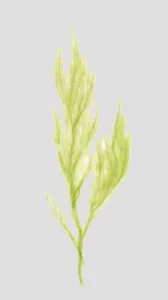
Order 5. Chaetophorales
- Plant body heterotrichous
- Hair or setae present
Family 1. Chaetophoraceae
- Filaments branched, branches free from one another or pressed together forming pseudoparenchymatous thallus
- Terminal cells modified into a long colourless setae (hair)
- Cells uninucleate with a single laminate and parietal chloroplast.
Examples :- Draparnaidiopsis, Fritschiella
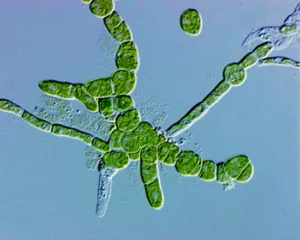
Family 2. Coleochaetaceae
- Vegetative cells with setae
- Sexual reproduction oogamous
Coleochaete
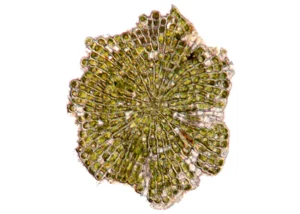
Order 6. Oedogoniales
- Filaments branched or unbranched
- Cell division resulting in ‘cap’ formation
- Chloroplast reticulate
- Zoospores and antherozoids multiflagellate
Family 1. Oedogoniaceae (Single family)
Example :- Oedogonium
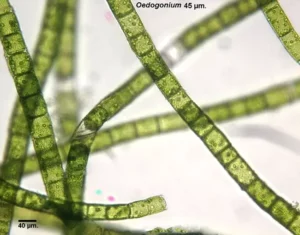
Order 7. Zygnematales
- Absence of flagellated reproductive cells
- Sexual reproduction by conjugation
Family 1. Zygnemataceae
- Filaments unbranched
- Chloroplast parietal and ribbon-shaped or single or two axial chloroplasts.
Examples :- Spirogyra, Zygnema
Family 2. Desmidiaceae
- Cells composed of two semi-cells
- Conjugating cells have chloroplast escaping from surrounding walls as they unite to form zygospores
Example :- Cosmarium
Family 3. Mesotaeniaceae
- Cells made of single piece and without pores
- Conjugating cells do not transfer contents from one cell to another
Example :- Netrium
Order 8. Siphonales
- A single, multinucleate and tubular cell (coenocyte) represents the thallus
- Chloroplasts many and discoid
Family 1. Caulerpaceae
- Thallus differentiated into rhizome, rhizoids and aerial folliar shoots, macroscopic
- Internally shows the presence of trabeculae
Example :- Caulerpa
Family 2. Codiaceae
- Thallus freely branched and tubular
- Sexual reproduction anisogamous and gametangia distinct
Codium
Order 9. Charales
- Thallus differentiated into nodes and internodes
- Characteristic sex organs-globule and nuclei
Family 1. Characeae (Single family)
Examples :- Chara, Nitell
CLASS II XANTHOPHYCEAE
- Chromatophores yellow-green
- Photosynthetic reserves-oil droplets
- Motile cells with unequal flagella
Order 1. Heterosiphonales
- Thalli multinucleate, unicellular and siphonaceous.
Family 1. Botrydiaceae
- Thallus unicellular, multinucleate, vesicular
- Zoospores biflagellate
- Sexual reproduction isogamous
Example :- Botrydium
Family 2. Vaucheriaceae
- Thallus branched, coenocytic, tubular and filamentous
- Zoospores multiflagellate
- Sexual reproduction oogamous
Example :- Vaucheria
CLASS III BACILLARIOPHYCEAE
- Chromatophores golden-brown or yellow with or without pyrenoids
- Cell wall made of two silicified overlapping halves
- Food reserve oil
- Reproduction mostly by simple cell division
Order 1. Centrales
- Valves circular, ornamentation radial or concentric
- Statospores or microspores formed
- Auxospores formed by oogamy
Example :- Melosira
Order 2. Pennales
- Valves bilaterally symmetrical, ornamentation bilateral
- Valves always with raphe
- Statospores or microspores never formed
- Auxospores formed by oogamy
Example :- Pinnularia
CLASS IV. PHAEOPHYCEAE
- Yellowish-brown chromatophores
- Laminarin and mannitol are reserve food products
- Reproductive cells with two unequal, lateral
flagella
Order 1. Ectocarpales
- Thallus filamentous
- Growth trichothallic
- Reproductive organs-unilocular and plurilocular sporangia
- Isomorphic alternation and generation
Family 1. Ectocarpaceae
- Thallus monoaxial, branched; branches uniseriate
- Uni-and plurilocular sporangia, terminal or intercalary
Example :- Ectocarpus
Order 2. Laminariales
- Sporophytes large, parenchymatous
- Sporangia in sori, on stipe and blade
- Gametophytes microscopic and dioecious
Family 1. Laminariaceae
- Sporophytes differentiated into holdfast, stipe and blade
- Blade simple or digitate
- Paraphyses hyaline or with colourless appendages
- Sporangia on both the surfaces of blade
Example :- Laminaria
Order 3. Fucales
- Plants parenchymatous with complex morphological and anatomical differentiation
- Medulla filamentous
- Asexual reproduction absent
- Sex organs in conceptacles
Family 1. Fucaceae
- Axes subterate to alate with midrib but not foliar
- Vesicle when present inercalary
- Oogonia with eight oospheres
Example :- Fucus
Family 2. Sargassaceae
- Axes terete, bearing distinct foliar organs
- Vesicles usually present, lateral or immersed in the terminal branchlets
- Branching of the thallus radial to the central axis
Example :- Sargassum
Order 4. Dictyotales
- Plants parenchymatous, less differentiated
- Branching often dichotomous.
- Growth by apical cells
- Asexual reproduction by tetraspores
- Isomorphic alternation of generation
Family 1. Dictyotaceae
- Gametophytes dioecious/monoecious
- Oogonia and antheridia in definite sori
- Sperms motile and eggs non-motile
- Sporophyte with tetrasporangia
Example :- Dictyota
CLASS V. RHODOPHYCEAE
- Chromatophores pure red to dark purple
- Photosynthetic reserve-Floridian starch or floridoside
- Male gametes and female gametes nonmotile and non-flagellated
- Female reproductive organ with a receptive organ-trichogyne
- Post fertilization product is called cystocarp
Sub-class 1. Bangioideae
- Thallus simple, growth intercalary
- Pit connections not well marked
- Asexual reproduction by gonidia ormonospores
- Sexual reproduction mostly unknown
Sub-class 2. Florideae
- Thallus basically filamentous
- Pit connections distinct
- Cells with more than one chromatophore
- Carpogonium highly specialized
Order 1. Nemalionales
- Plants filamentous, corticated, uni- or multiaxial
- Cells uninucleate, chromatophores axial or lateral
- Cystocarps superficial or embedded in the thallus
- Life cycle without free living tetrasporophyte
Family 1. Batrachospermaceae
- Fresh water members
- Thallus uniaxial
- Life cycle haplobiontic
Batrachospermum
Order 2. Gigartioales
- Plants filiform, fleshy-membranous or crustose; corticated and multiaxial
- Tetrasporangia scattered on plants.
- Spermatangia borne on surface at special points
- Carpogonia embedded in the cortex
Family 1. Gracilariaceae
- Branches terete and firm
- Outer cells not radially serrate
- Narrow, small celled assimilatory cortex bearing delicate, colourless hairs
- Medulla parenchymatous
- Tetrasporangia tetrapartite
Example :- Gracilaria
Order 3. Ceramiales
- Thalli uni- to mutiaxial
- Filaments corticated, polysiphonous
- Spermatangia in cluster
- Presence of trichoblasts
Family 1. Ceramiaceae
- Thallus monosiphonous
- Naked or corticated by secondary filamentsdeveloped at nodes
- Procarp exterior to the thallus
- Tetrasporangia usually tetrahedral and external
Example :- Ceramium
Family 2. Rhodomelaceae
- Axes polysiphonous
- Axes naked, corticated or covered with branches
- Main axis surrounded with pericentrals
- Plants bushy, sparingly branched; branches delicate
Example :- Polysiphonia
CLASS VI. MYXOPHYCEAE
- Plastids not organised
- Pigments blue-green in colour
- Photosynthetic reserve-cyanophycean starch or glycogen
- True nucleus absent, cells prokaryotic
- Sexual reproduction not known
Order 1. Chroococcales
- Plants unicellular or colonial
- No differentiation into base and apex
- Nannocytes often present
Family 1. Chroococcaceae
- Cells unicellular or forming colomes
- Filaments no known
Example :- Gloeocapsa
Order 2. Nostocales
- Thallus with trichomes
- Trichomes unbranched or with false branching
- Hoqnogones, heterocysts, exospores, endospores, etc. present
Family 1. Oscillatoriaceae
- Trichomes uniseriate, sometimes tapering a the ends
- Heterocysts and spores absent
- Sheath absent or diffluent
Example :- Oscillatoria
Family 2. Nostocaceae
- Trichomes simple, unbranched, uniseriate, undifferentiated
- Heterocysts and akinetes present
Example :-Nostoc
Family 3. Scytonemataceae
- Trichomes uniseriate, without marked attenuation
- Filaments free, with false branching
- Sheath firm enclosing one or more trichomes
Example :- Scytonema
Family 4. Rivulariaceae
- Trichomes markedly attenuated from base to apex
- Trichomes show false branching
- Growth trichothallic with terminal hair
Examples :- Rivularia, Gloeotrichia

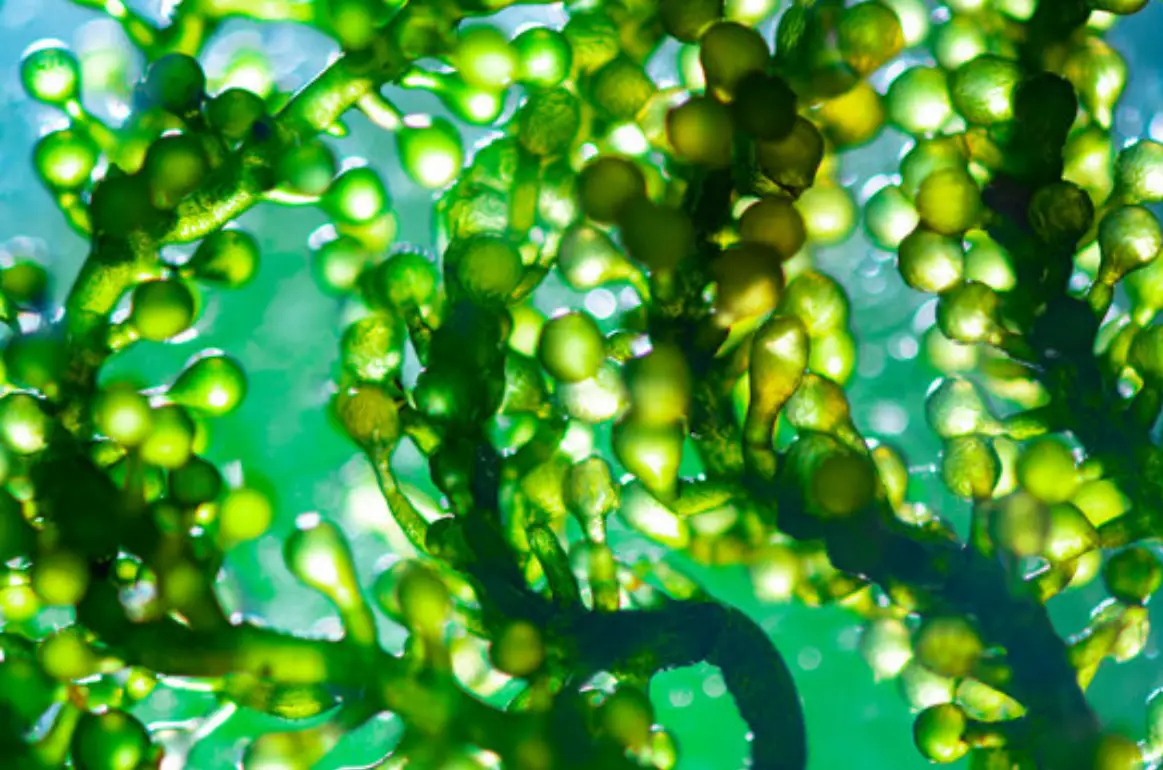
Leave a Reply